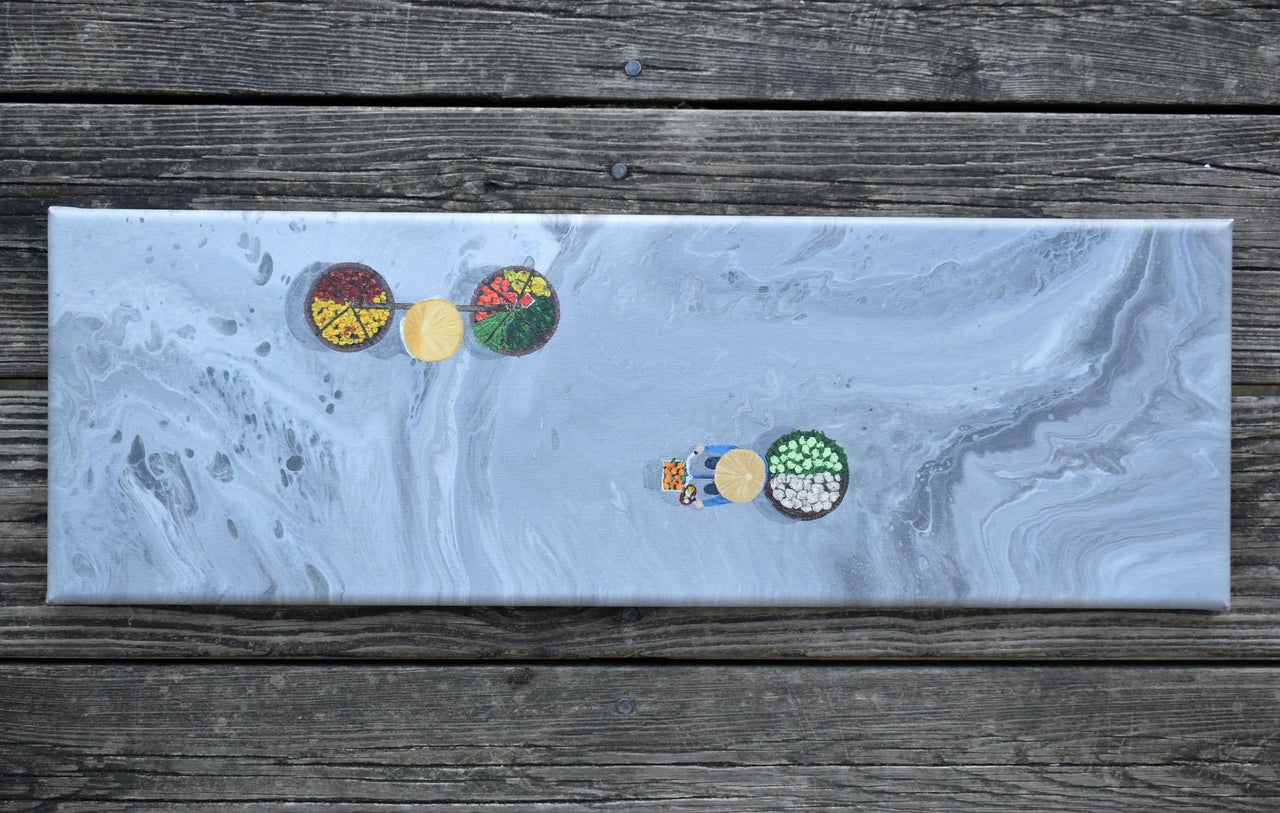Local Kansas City artists target climate change and wealth inequality

From ancient Greece to the Dadaists, a movement consisting of artists who rejected modern capitalist ideology and instead focused on irrationality, critique has paved the way for new eras in political thought. Praxiteles subverted gender expectations with “Aphrodite of Knidos” just as Duchamp condemned standardization with “3 Standard Stoppages.”
Recently, climate change has been a more common focus of such protest-art. In 2010, Maya Lin drew attention for her “What is Missing?” memorial. Long famous for her work designing the Vietnam War Memorial, Lin’s “final memorial” addresses the 6th mass extinction, which is not just currently ongoing, but accelerating.
Kansas City, too, is home to professional and budding artists converging on the climate crisis, a leading policy priority in public opinion.
A painter’s perspective
Elizabeth White, a painter with a non-traditional path and a social worker by trade, approaches art from the perspective of how people experience nature. By using her acrylic paints, White finds peace in her family’s camping getaways and loves being immersed in the outdoors.
Her family tries to avoid glamping, she said, and when they take trips they focus on enjoying elements of nature before they’re gone. White, who finds peace in creating depictions of natural beauty, said she wants her work to evoke positive feelings in its viewers.
White became captivated and inspired by the spiraling effects of deforestation after moving to the Kansas City area from Iowa. The lack of nearby nature trails and natural areas caused her to lament the other aspects of nature that are slowly being eroded, she said.
White specializes in aerial perspective, and most of her works relate to personal experiences she’s had in nature. “Lake Life,” a part of the Missouri Art Now bicentennial exhibition showcases how humans can experience nature without negatively impacting it. She noted the piece contains kayaks, not motorboats; it’s meant to relax the viewer.
“When I’m looking at it, I really think about being at peace with nature, being out on the lake, not needing technology,” White said, “I try not to put buildings and things in my art.”
While studying anthropology in college, White discovered the floating markets of Vietnam, and was taken with their charm. She was captivated by the more harmonious way of trading goods without use of motorized vehicles, and took inspiration from the nation’s bicycle vendors as well. “Floating Market Finds” and “Street Vendors of Hanoi” are both celebrations of the healthier and more environmentally friendly form of commerce.
“They’re not driving around in their trucks, they’re pedaling to get their produce or their flowers or whatever they’re selling out there,” White said. “It would be awesome to see that kind of thing out here.”
A ceramicist’s stand
Loren Vladem, an undergraduate ceramicist at the Kansas City Arts Institute, tailors her approach toward the darker elements of capitalism and wealth inequality. Vladem says she’s often stuck with a sense of existential worry toward the climate and the future of humanity, and her work reflects that dread.
“I’d probably want kids more if the future wasn’t so bleak,” Vladem said, noting that so far, millions of people have been “left in the dust” to fend for themselves in water starved areas. Vladem is revolted by the concentration of wealth among corporations who profit from natural resources essential to life, like Nestle, whose CEO said the idea that water is a human right is “extreme.”
Vladem’s “Thirsty?” series of vase-shaped pitchers, inspired by Iranian ewers, addresses the water crisis and the unequal access to water. The ornate, blue-glazed tops contrast with cracked, parched-looking earthy lower sections of the vessels.
“They’re non-functional,” Vladem explained. “Water is not meant to be poured from them.” Vladem said the pieces are a statement on taking water from communities that are already starved, noting that Nestle does have a bottled water factory in Iran.
“Increasingly Threatened” is a series of anthropomorphized coral figures Vladem crafted to address the continual decline of ocean health. The figures are shown in a council formation, “almost like they’re having a bleak meeting about the end of it all,” she said.
On one end, the figures are teeming with rich colors and life, which gives way to bleached and desolate figures suffering the effects of ocean acidification. The set of figures was inspired by the complex ecosystem dependent on coral, and is meant to draw attention to their significance. Vladem noted that coral acts as a barrier to tropical storms, protecting coastal communities from weather events expected to worsen with climate change.
Vladem has also crafted a series of cups titled “Death in the Family,” which seeks to address greed and wasted excess.
Vladem says her work helps ease the anxiety of what she sees as a continual denial of responsibility toward the environment.
“The date keeps getting pushed back,” she said, “we’ve known about climate change since the 60s, we hear a lot about 2050, what’s it gonna be next, 2070? 3000?”
Vladem’s art can be found on her Instagram, where she will note future exhibition and gallery showings. White’s art can be found on her Instagram, her website, the KC Art Garden on certain Sundays, and Overland Park’s upcoming Fall Festival.
